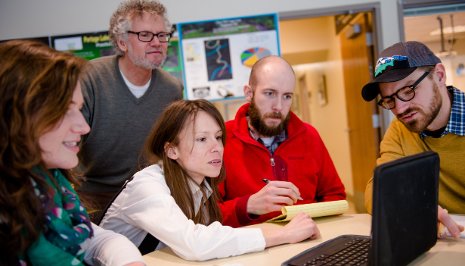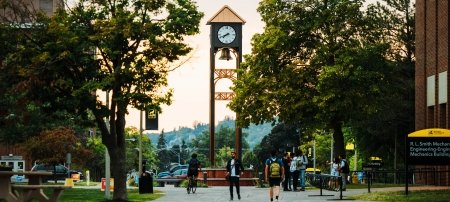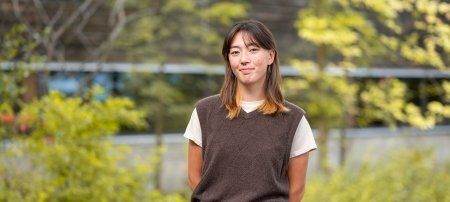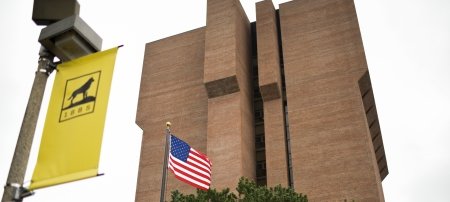PhD Students Learn to Communicate their Research

Scientists and engineers earn PhDs so they can do research. But they rarely consider the importance of communicating their research to the general public, teachers and school children, or the news media—a major conduit to the public.
What can happen if researchers don’t open that line of communication with the public? Lots of bad things. Their funding can dry up as policymakers who don’t understand science pull the plug. Advocacy groups can unite to oppose their research for any reason or none at all. The news media can misinterpret and disseminate misunderstanding.
With a National Science Foundation (NSF) grant, a civil and environmental engineering professor at Michigan Technological University is trying to help the next generation of PhDs learn to better communicate their research. Alex Mayer, the Charles and Patricia Nelson Presidential Professor at Michigan Tech, runs a fellowship program that teaches PhD students in a variety of fields to explain their research in K-12 classrooms and to write news releases to communicate with the public through the media. Others working with him on the grant are Nancy Auer, Biological Sciences; Brad Baltensperger, Cognitive and Learning Sciences; Kathleen Halvorsen, Social Sciences and School of Forest Resources and Environmental Science; Shawn Oppliger, Copper Country Intermediate School District; and Linda Nagel, formerly at Michigan Tech, now at the University of Minnesota.
During the fall semester, the graduate students learn the fundamentals of news release writing from Jennifer Donovan, director of news and media relations at Michigan Tech. Then, as their class assignment, each fellow chooses a challenging science communication issue and researches and writes a news release about it.
Here are this year’s student releases.
Howling at the Public will not Communicate your Message
By Nicholas Bolton
Wolves have been at the center of much debate lately. Should we manage them on Isle Royale? Should we hunt them on the mainland? John Vucetich, a researcher at Michigan Technological University’s School of Forest Resources and Environmental Sciences (SFRES) believes that much more is being discussed when people start communicating about wolves.
“Wolves are a symbol of all that we love about nature for some, and they also can be a symbol of fear for others,” Vucetich says. To cut through the emotional carnage that often arises in the wolf controversy, Vucetich has a clear game plan. By respecting others’ opinions and being as clear and transparent as possible, he believes he can present his findings in an efficient manner.
Chris Webster, an expert on white-tailed deer, the primary food source for wolves, says that his first step when communicating his research is to solidly place his work in a historical setting. This provides the audience with the same background information when they get to the meat of his findings.
Many people are interested in the science that is being studied in the School of Forest Resources and Environmental Sciences at MTU. The community liaison specialist for SFRES, Hannah Abbotts, says she receives questions from the public about once a week. Hannah says her job is to “Quickly assess their understanding of the topic to appropriately convey my message at their level of understanding.” As the community liaison specialist, she also is able to tell the individual whom to contact in for further information.
What all three of these individuals emphasized when they discussed communicating wolf ecology is respect. By respecting their audience, they feel they can transfer their knowledge in a clear and comprehensible way.
The Communication of River Restoration
By Brian Danhoff
More than half of rivers in the United States are in poor health according to a 2013 report by the US Environmental Protection Agency (https://www.epa.gov/environmental-topics/water-topics). At the forefront of the effort to improve that statistic are numerous scientists and engineers, including three members of the Michigan Tech faculty: Brian Barkdoll Casey Huckins and Amy Marcarelli.
One of the many challenges faced in restoring rivers is communicating the needs and the successes and failures of projects. Researchers need to be thoughtful in how they frame the potential restoration, the Michigan Tech scientists say.
“Where I think scientists do a poor job of communication is often the promise and results [of the restoration] are oversold” explains Huckins, associate professor in the Department of Biological Sciences, who has focused much of his research on restoring coaster brook trout to the Salmon Trout River. Marcarelli, assistant professor of biological science, notes that scientists tend to focus their communication efforts early on, “I think we tend to emphasize when a new restoration project has started, but ignore the follow through in communicating the post-restoration effects to the public”.
Despite missteps in how science is communicated, it may not be solely a lack in communication skills. “We [the public] are overloaded by so much information. It can be hard to get people’s attention, especially on an issue they don’t see in their daily lives,” says Barkdoll, associate professor of civil and environmental engineering. “By the time we’re caught up on Facebook and Twitter, among other things, we’ve run out of interest and patience to read about things such as stream restoration” he explain.
The challenge becomes to find the most effective way to get restoration news to the public. There are numerous outlets for communication, including workshops, social media and public forums.
One of the keys to communicating restoration is word choice. “Can I put my research into a language that my grandma would understand?” Barkdoll says. “If she can understand it, then I think most people could understand it.”
Sometimes the most effective way is to partner with those whose job is communication. “One of the ways I get my science to the public is by communicating with the people who are better at communicating with the public than I am, such as reporters, state agencies or conservation groups” says Marcarelli.
With many options for getting science to the public, Huckins believes that technology will play a key roll in that communication. “The Internet is likely to be the primary mode of communication going forward, but it has inherent problems and limitations,” he says. The key going forward for scientists doing restoration will be not only packaging their research in a language that everyone understands, but finding fresh and novel ways to get it into the minds of an increasingly busy public.
Communicating Nanoscience and Engineering – Possibilities and Pitfalls
By Anika Kuczynski
Have you ever wondered what’s in your sunscreen, tennis racket, fabrics, and windows to increase absorption, decrease weight, reduce wrinkling and staining, and repel water? In many cases, it’s nanoscale additives that were engineered to improve these products.
Nanoscale science and engineering is a flourishing field that holds great potential for solving current and future problems. Applications in electronics, sustainable energy generation, health, and environmental remediation could revolutionize our way of life. What if we could engineer “nanobots” to combat and defeat cancer cells? What if nanomaterials could solve the problem of energy storage, enabling us to build super batteries and highly efficient solar cells?
One problem with nanoscale science and engineering is that many people don’t understand or have much interest in it. Another is that benefits have been promised that may have raised expectations to an unrealistic level. What is the real possibility of having “nanobots” work inside our bodies? Good communication between researchers and the general public is essential to avoid misconceptions.
But what is the best way to communicate with an audience unfamiliar with the nanoscience and engineering community? Yoke Khin Yap, professor of physics and adjunct professor of materials science and engineering, says, “In order to communicate really effectively, you need to speak in their language.” Scientists routinely use jargon, which is much too complicated for most of us to follow. But, as Hugh Gorman, professor of environmental history and policy, puts it, “The jargon is not useless. It’s efficient for people who speak the same language, just like when you text something and leave out letters, but to a non-native English speaker, it would be problematic to understand the message.” For non-native science speakers, simplifications, metaphors and analogies to familiar things in everyday life can be good tools for communication.
Further, it’s important to remember that seeing is believing. Yap says, “You have to make them visualize.” Experts must put themselves in the shoes of lay people and use animations, images and simulations to help people gain an understanding of what happens at the nanoscale (one billionth of a meter).
The fact that our naked eye cannot see what happens at the nanoscale can be disconcerting. Bruce Seely, dean of the College of Sciences and Arts and a historian of technology, points out: “For many people the fact that you can’t see is mysterious, magical and scary. And if you can’t directly sense any of this, how can you trust that something is going to happen the way that someone promises it will? We’ve come to be skeptical of many promises of science because of past failures for those promises to be realized.”
As with any new technology and development in science, society must not only be informed about but also weigh the risks in proceeding with applications of nanotechnology. Seely points out that “weighing risk is not about deciding all or nothing. We must ask ourselves at what level we are willing to take chances. Hopefully, in some cases, the side effects are so potentially great that we don’t go there. And in other cases, the side effects can seem manageable or small compared to the potential benefits.”
In any case, Yap and Seely agree that it’s vital for nanoscientists to help people understand what they are doing, why it matters, and what the benefits and risks might be.
Filling our Fuel Tanks with Trees
By Michelle Miller
What do a chemical engineer, a social scientist and a soils scientist have in common? All are involved in research at Michigan Tech that is looking at replacing some of our fossil fuel consumption with energy derived from biomass.
The biomass-related research requires collaboration and communication among researchers and other professionals from many different departments at Michigan Tech. As. Kathleen Halvorsen, professor of natural resource policy, points out: “This is not a simple issue. Bioenergy is arguably the most complicated form of energy because you can make it from so many different feedstocks.”
In addition to communicating across disciplines, these researchers recognize societal worries about bioenergy, and therefore a need to communicate effectively with the public. “One public concern is that biofuels will compete with food,” says David Shonnard, Robbins Chair professor of chemical engineering and director of Tech’s Sustainable Futures Institute. “This is a genuine and important issue.” But his communication about using woody biomass from tree residue, along with Halvorsen’s, avoids the food controversy because wood is not generally used for food and focuses other, more positive implications. “Urban wood waste generates methane, a landfill gas that is 25 times more potent than CO2 as a greenhouse gas,” Shonnard explains. “Using this waste for biofuels can actually decrease emissions, a positive step for climate change mitigation.”
Evan Kane, a soil scientist at the U.S. Forest Service and assistant professor at SFRES, says that Joan Chadde, director of the Center for Science and Environmental Education at Michigan Tech, has been his best avenue for communicating his research with the public. “We’ve collaborated on grants with her, enabling teacher institutes and other outreach programs; these have given me and my colleagues the opportunity to communicate our research to hundreds of students, as well as K-12 teachers,” he explains.
Teachers and students from across the country have visited Michigan Tech researchers’ labs, giving them an opportunity to better understand biofuels research. This summer, Shonnard worked with a program funded by the National Science Foundation, in which teachers spent six weeks on the Michigan Tech campus learning about biofuels. These teachers brought their new knowledge, including lab kits to make ethanol from woodchips, back to their classrooms to share with the next generation of scientists and citizens.
Many scientists at Michigan Tech realize that a vital component of their research is communicating it accurately, yet effectively, to the public. Some scientists are able to do this directly, while others find it helpful to collaborate with those that specialize in outreach.
No Monkey Business: Animal Welfare and Safety at the Heart of Michigan Tech Scientific Animal Use Policy
By Patricia Spellman
Sometimes, the only way to make progress in curing human diseases is to use animals in research. But using animals for scientific research requires a delicate touch, one that Michigan Tech handles with prudence and care. By adhering to strict protocols, Michigan Tech provides a safe and secure environment where advances in science and medicine can flourish while the safety and well-being of all animals is ensured.
In order to use animals for research in the lab at Michigan Tech, a rigorous protocol must be followed. This involves first submitting an application to Institutional Animal Care and Use Committee (IACUC), which oversees animal welfare and safety at Tech. It consists of a minimum of five members, one of which comes from outside the university. The committee reviews the proposed research and determines if it is even appropriate to use animals for the objective or if alternatives exist. Committee members evaluate how the researchers will handle the animals, including housing requirements and making sure their health and safety are maintained throughout. Additionally, a veterinarian is always on staff to make sure the animals remain in good care, with assistants who are thoroughly trained to handle the animals properly.
The committee requires that the fewest possible animals be used for proposed research. If the lab is even one rat over, the research permit is terminated. Even a perfect application can take upwards of 2 weeks to be approved. However, usually many revisions are required before any experiments can begin.
"We actually have more stringent regulations than federal guidelines require" states biosafety officer David Dixon. These regulations ensure that animals are well taken care of and minimize any problems that could occur.
Over the years, Michigan Tech has made numerous advances in understanding human physiology and disease with the aid of animals. Currently, headway is being made on diabetes research in Xiaoqing Tang’s laboratory. Tang is a biological sciences professor at Tech who is attempting to find a therapeutic approach to cure this widespread affliction. Before conducting any research with animals, she first tests the approach in the cell line and then confirms her results using mice. “We try to use the animals as little as possible,” she says. However, without being able to use mice in her lab, her research would never progress.
Additional research into cancer is being conducted in Professor Thomas Werner’s lab. Werner, also in the Department of Biological Sciences, is utilizing a novel approach by linking mushroom toxin resistance in the fruit fly genus Drosophila as model to understand the molecular pathways that lead to disease. “The only reason we use animals is that animals are so similar to humans,” he explains. “We can ask the same questions in animals and get the relevant answers for humans.”
There is a common misconception from those who oppose animal research that animals are often subject to maltreatment in laboratory settings. Courtney Perreault, who oversees animal welfare at Michigan Tech, says this couldn't be farther from the truth here. The animals at Michigan Tech facilities are treated with respect and receive the best of care. Much of the perceived mistreatment is due to propaganda using images that are from abuse cases rather than actual laboratory environments. "There is no way to combat that" she says. "It's an image that sticks in people’s minds, and that’s what they want to believe."
Michigan Tech enacts strict rules to maintain animal safety while concurrently facilitating the advancement of medical research. It is important to balance the necessity of biomedical progress with the care and safety of all involved in the methods. And Michigan Tech is striving to do just that.
Michigan Technological University is a public research university founded in 1885 in Houghton, Michigan, and is home to more than 7,000 students from 55 countries around the world. Consistently ranked among the best universities in the country for return on investment, Michigan’s flagship technological university offers more than 120 undergraduate and graduate degree programs in science and technology, engineering, computing, forestry, business and economics, health professions, humanities, mathematics, social sciences, and the arts. The rural campus is situated just miles from Lake Superior in Michigan's Upper Peninsula, offering year-round opportunities for outdoor adventure.




Comments